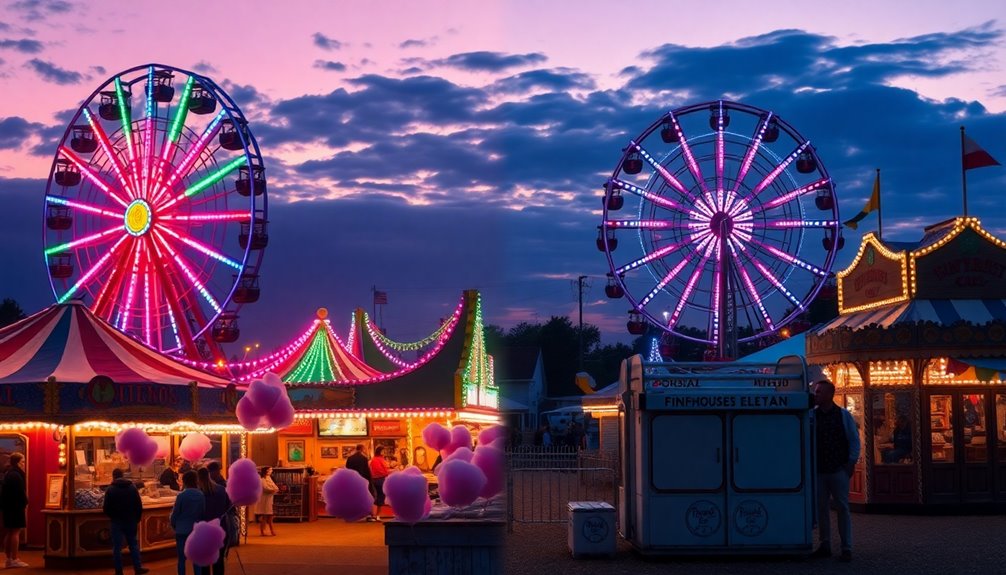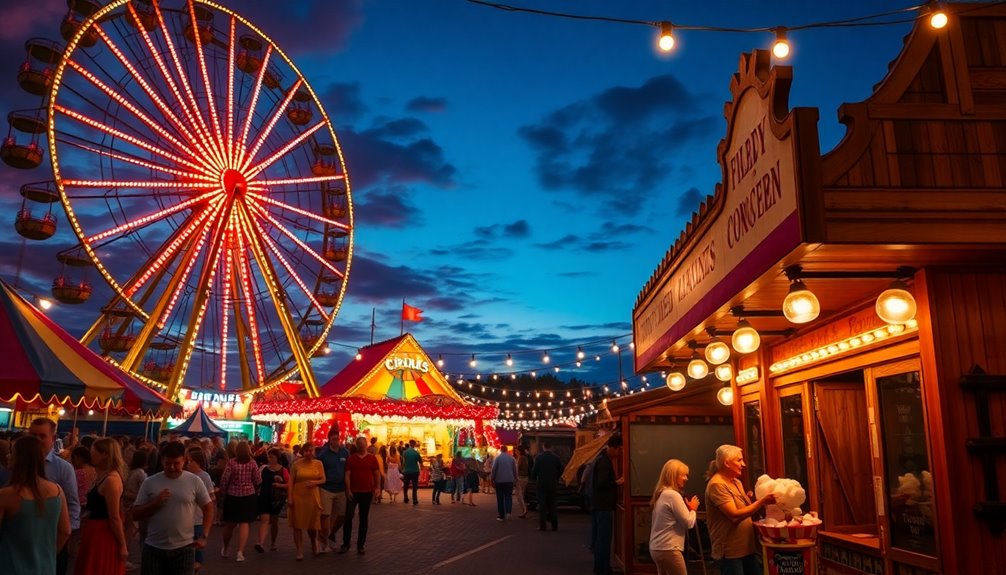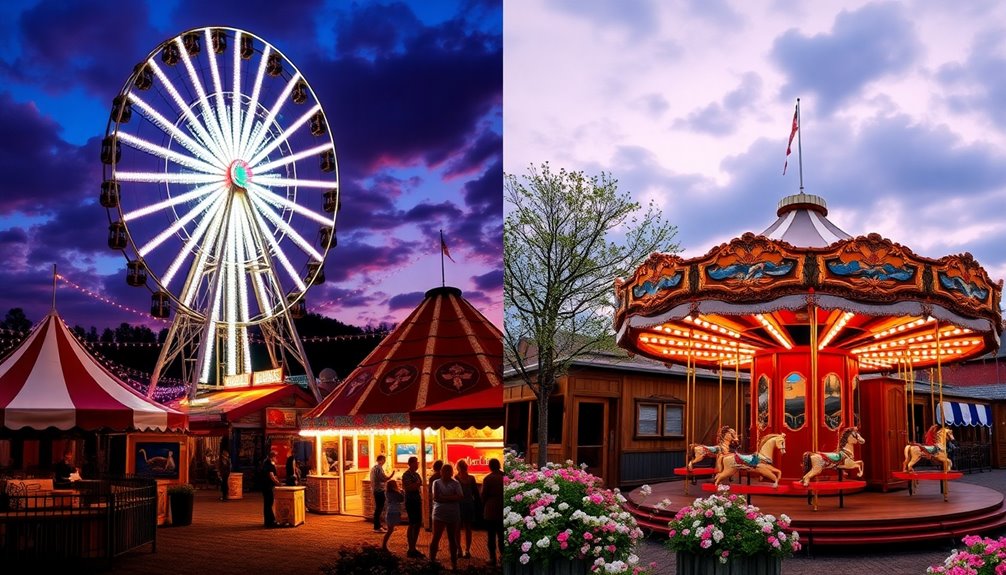Carnivals and fairs both offer unique fun experiences, but they serve different purposes. Carnivals focus on entertainment, featuring thrilling rides, games, and indulgent treats like funnel cakes. They create a festive atmosphere, often happening before Lent. In contrast, fairs emphasize community engagement through agricultural competitions, local crafts, and educational demonstrations. You'll find events like livestock judging and cooking contests that celebrate local talent. While both foster a sense of belonging, understanding their distinct features can enhance your enjoyment. So, stick around to explore more about what makes each event so special.
Key Takeaways
- Carnivals focus on entertainment with thrilling rides and games, while fairs emphasize competitive events like livestock judging and cooking contests.
- Carnivals feature classic foods like cotton candy and funnel cakes, whereas fairs highlight local agricultural products and craft exhibitions.
- Carnivals typically occur before Lent and are more seasonal, while fairs are held annually and celebrate local culture and community.
- Competitive aspects are central to fairs, reinforcing local pride through awards, unlike carnivals which prioritize amusement and enjoyment.
- Both events foster community engagement and create lasting memories, but they differ in emphasis on entertainment versus competition.
Defining Carnivals

Carnivals are vibrant gatherings that blend music, entertainment, and thrilling rides, offering an exciting experience for all ages.
Originating from traveling shows in the 19th century, these events have evolved into modern carnivals brimming with attractions like dunking booths, thrill rides, and obstacle courses.
You'll find a lively midway filled with games and entertainment, drawing crowds from near and far.
Historically, carnivals celebrated the shift from winter to spring, often marked by indulgent festivities before Lent.
When you attend, don't miss out on classic carnival foods like cotton candy, funnel cakes, and fried dough, which have become staples.
Whether you're riding amusement rides or enjoying the atmosphere, carnivals promise unforgettable fun and excitement.
Understanding Fairs

When you think of fairs, picture the vibrant community engagement that takes place through various activities and competitions.
You'll see everything from livestock judging to cooking contests, showcasing local talent and produce.
These events not only highlight competitive spirit but also bring people together for a fun and festive atmosphere.
Community Engagement Activities
Fairs truly shine as community-focused events that bring residents together to celebrate local culture and achievements.
You'll find that county and state fairs foster community engagement through various activities that highlight regional pride. Here are some key aspects you can expect:
- Competitions in livestock judging and cooking contests
- Showcases of local craftsmanship and agricultural achievements
- Family-friendly activities that cater to all ages
- Carnival rides and games adding an element of fun
While fairs vs. carnivals may differ in focus, fairs emphasize community spirit by involving local businesses and residents in organizing events.
Attendance reflects high community involvement, creating a vibrant atmosphere where everyone can connect and celebrate together.
Competitive Exhibitions and Showcases
Local fairs take pride in showcasing competitive exhibitions that highlight the talents and skills of community members.
You'll find exciting events like livestock judging, where participants present their best animals for awards and recognition. Cooking contests, including cake judging, are also popular, letting local bakers demonstrate their culinary prowess.
Many fairs feature various competitions that emphasize craftsmanship, such as quilting and crafts, fostering community pride.
State fairs often take this to another level by showcasing agricultural innovations and promoting local produce, with exceptional entries receiving awards.
These competitive exhibitions create a vibrant atmosphere, bringing people together and celebrating the unique skills within your community, all while drawing substantial attendance and showcasing the competitive spirit that fairs embody.
Key Differences

When you compare carnivals and fairs, you'll notice distinct differences in attractions, duration, and setup.
Carnivals focus on thrilling rides and games, while fairs highlight local culture through competitions and exhibits.
Plus, carnivals are mobile and can pop up year-round, whereas fairs are typically seasonal and rooted in a specific location.
Types of Attractions
While both carnivals and fairs offer fun and excitement, their types of attractions set them apart markedly.
In the battle of carnivals vs. fairs, you'll find that carnivals focus on entertainment attractions, featuring thrill rides and immersive experiences. In contrast, fairs shine with agricultural competitions and local craftsmanship.
- Thrill rides and games of chance at carnivals
- Livestock judging and exhibitions at fairs
- Classic fair treats versus regional local cuisine
- Sideshow performances versus community engagement activities
At carnivals, you can immerse yourself in skill-based games, while fairs celebrate local culture and achievements.
Each has its charm, but knowing these differences helps you choose the right experience for your next outing!
Duration and Frequency
Understanding the duration and frequency of carnivals and fairs can help you plan your visits more effectively. Typically, traveling carnivals last just a few days and move from town to town, making them shorter events.
In contrast, fairs are larger, community-based gatherings that can span several days to weeks and usually occur annually. While traveling carnivals may operate year-round in warmer climates, fairs generally take place once a year, aligning with local festivals or agricultural seasons.
The duration of attractions at carnivals is often brief, focusing on quick entertainment, whereas fairs host longer competitions and exhibitions that engage attendees for extended periods. Knowing these differences can enhance your experience at both events.
Location and Setup
Carnivals and fairs differ considerably in their location and setup, shaping the overall experience you'll have at each event.
- Carnivals are traveling shows, moving from town to town, often setting up temporarily.
- Fairs are community-based events, held annually in fixed locations like fairgrounds or parks.
- The setup at carnivals is compact, with rides and games closely arranged, while fairs feature extensive grounds for exhibitions and competitions.
- Fairs may include permanent structures for multi-day events, unlike the portable equipment used in carnivals.
Understanding these key differences in location and setup can help you choose which experience suits your interests best!
Popular Attractions

When you think of popular attractions, the differences between carnivals and fairs become clear.
Carnivals boast thrilling rides like roller coasters and Ferris wheels that elevate your sensory experience. In contrast, fairs focus on traditional attractions such as livestock exhibits and local competitions.
You can try your luck at carnival games like ring toss or basketball shooting, which have shifted from live animals to stuffed toys.
Food is another highlight: carnivals tempt you with indulgent treats like funnel cakes and cotton candy, while fairs showcase community specialties and cooking contests.
The vibrant atmosphere of a carnival, filled with bright lights and upbeat music, contrasts with the more community-oriented spirit of fairs, offering a unique experience at each event.
Cultural Significance

The vibrant atmosphere of carnivals and the community spirit of fairs both highlight their cultural significance within society. These cultural events foster community engagement and create lasting memories.
- Celebrate local agriculture and traditions
- Promote community identity through shared experiences
- Showcase local talents via competitions and exhibitions
- Strengthen social bonds among diverse groups
Carnivals often reflect indulgence and celebration, while fairs serve as platforms for showcasing local produce and crafts.
Both events play an essential role in preserving traditions and enhancing community ties. Through their lively gatherings, they not only boost local economies but also weave a rich tapestry of cultural heritage, reinforcing the sense of belonging and continuity in your community.
Historical Context

While both carnivals and fairs have deep-rooted histories, their origins reveal distinct purposes and cultural evolutions.
Carnivals originated as celebrations marking the end of winter and the arrival of spring, with roots tracing back to Germanic tribes around 98 AD. The Catholic Church later adopted these traditions before Lent, emphasizing indulgence for two to three days. In North America, traveling carnivals gained popularity in the 19th century, especially after the 1893 Chicago World's Fair showcased thrilling rides and entertainment.
Conversely, fairs began around 1841, focusing on agricultural competitions and community bonding, with Pittsfield, Massachusetts, recognized as the birthplace of state fairs.
While carnivals emphasize entertainment and rides, fairs incorporate competitive elements like livestock judging and local craft exhibitions.
Frequently Asked Questions
What's the Difference Between a Carnival and a Fun Fair?
A carnival and a fun fair both offer excitement, but they differ in focus.
At a carnival, you'll find thrilling rides and games designed for pure entertainment, often with a vibrant atmosphere.
In contrast, a fun fair usually highlights community aspects, featuring local crafts, food booths, and competitions.
While both provide enjoyment, carnivals emphasize amusement and spectacle, while fun fairs celebrate local culture and community engagement.
What Is the Difference Between a Fair and a Fun Fair?
When you think about a fair, you picture agricultural competitions, livestock exhibitions, and local craftsmanship, right?
A fun fair, on the other hand, is all about entertainment, thrill rides, and games.
While fairs are larger community events often held annually, fun fairs can pop up temporarily in various locations.
You'll find different food vendors too; fairs might showcase local specialties, while fun fairs serve traditional carnival snacks like cotton candy and funnel cakes.
What's the Difference Between a Carnival and an Amusement Park?
When you think about a carnival and an amusement park, you're looking at two distinct experiences.
A carnival travels from place to place, offering smaller rides, games, and local food for a limited time.
In contrast, an amusement park is a permanent destination filled with larger attractions, live shows, and themed areas.
You'll pay differently too; carnivals often use a pay-per-ride system, while amusement parks have set admission prices for broader access.
What Is the Difference of Carnival and Carnaval?
When you think about a carnival, you're picturing a traveling event filled with rides and games, right?
Carnaval, on the other hand, is all about vibrant cultural celebrations, often featuring parades, music, and dance.
You'll notice that while carnivals can pop up anytime, Carnaval happens during a specific season leading up to Lent.
Each offers a unique experience, with carnivals focusing on amusement and Carnaval showcasing local traditions and community spirit.
Conclusion
So, whether you're dodging flying cotton candy at a carnival or contemplating the existential dread of winning a goldfish at a fair, it's clear that both offer their unique flavors of fun. Just remember, while a carnival's all about thrill rides and dazzling lights, a fair's more like your cousin's backyard barbecue—complete with questionable food choices and an oddly competitive pie-eating contest. Either way, you're bound to have a blast, or at least a story to tell!








